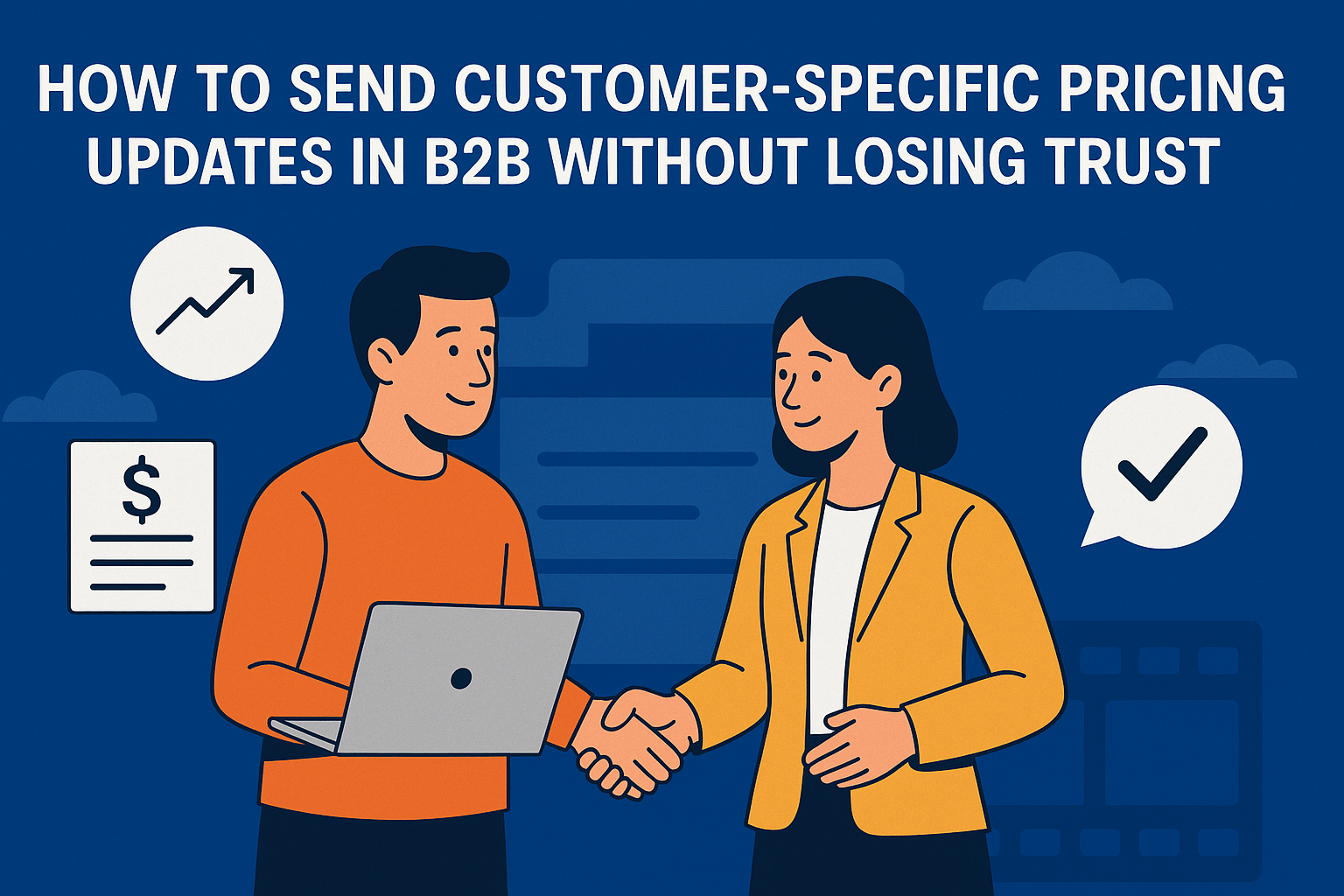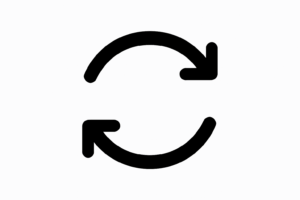Why Transparent Price Change Communication Builds Loyalty, Not Just Clarity
Industrial B2B buyers don’t place orders casually. They commit. When a buyer submits a PO, it’s because they’ve done the math. They’ve reviewed cost-per-unit, factored in freight, compared margins, checked with finance, and often had to justify the decision to someone else in the organization.
So when a pricing change hits unexpectedly, whether it’s a 4% increase on a core component or a surcharge that wasn’t there last month, it doesn’t just raise eyebrows. It shakes the whole relationship.
It’s not about the number. It’s about the shock.
Because behind every part number is a production schedule. Behind every SKU is a margin calculation, a budget line item, and often, a set of upcoming purchasing decisions. When pricing updates are delivered inconsistently or worse, silently, your brand stops being a partner and starts being a risk.
This article is about fixing that.
We’re going to show you how to implement a transparent, automated, and human-centered pricing update notification system. Not just to avoid friction, but to build trust, reinforce your role in the customer’s operations, and position your ecommerce infrastructure as a source of stability, not chaos.
The Hidden Cost of Surprise: Why Pricing Updates Break Trust in B2B
Let’s zoom in on the real impact.
Imagine a plant manager in Indiana. She’s already behind schedule. Her production line needs $14,000 worth of pneumatic fittings by next Tuesday. She places the order, same part numbers, same quantities as last time. But this time, without warning, the total is $16,200.
Now she’s got a problem she didn’t plan for. And a boss asking questions she doesn’t have answers to.
This isn’t a fringe scenario. It happens every week. Because in most B2B environments, pricing updates are handled reactively. Someone in finance updates the ERP. The ecommerce store syncs the new prices. No one thinks to notify the actual people who are affected until the angry email comes in.
But here’s what that email means: the customer no longer trusts that your system has their back.
In industrial supply, trust is earned through reliability. And reliability isn’t just “we ship fast.” It’s “we keep you informed.”
Buyers aren’t asking for prices to never change. They’re asking for clarity, consistency, and lead time. Even a 2-week heads-up can mean the difference between a smooth reforecast and a full-blown fire drill.
And when you give them that heads-up, proactively, and through the channels they already use, you move from being just a vendor to being part of their planning process.
That’s how you win repeat POs. That’s how you protect margins without burning bridges.
That’s the job of your pricing update system—not just to deliver numbers, but to safeguard the relationship.
Why Most Pricing Update Systems Fail
In theory, pricing updates are simple: change the number, notify the buyer, move on.
But in practice, most systems fail for one of two reasons. Either they rely entirely on humans to remember who needs what, or they treat all customers the same, blasting generic announcements into the void and hoping the message sticks.
Neither approach works. Especially not in industrial supply, where pricing isn’t one-size-fits-all.
Some customers have tiered discounts. Others are locked into contract pricing from 2022. And many operate within agreements that span two or more companies, distributors, vendors, and end-buyers, all relying on shared pricing accuracy. Some only buy quarterly; others hit reorder every 10 days. You can’t notify them the same way. You shouldn’t even speak to them the same way.
But most B2B ecommerce setups are built on catalogs, not relationships. The ERP knows the pricing, sure, but Shopify or BigCommerce might not. And even if they do, those changes rarely trigger communication.
You might have a sales rep who remembers to call the big accounts when a price change hits. But what about the 80 other buyers with custom terms? What about the ops manager who does the reordering, not the person who negotiated the contract?
This is how trust erodes in quiet ways. The pricing changes. Nobody says anything. The buyer finds out mid-checkout or mid-PO. Suddenly, your reliability and the overall customer experience are in question.
And here’s the kicker: it’s not even the price that bothers them. It’s that they had no time to react.
A 5% increase is manageable. A 5% surprise is not.
So, what’s needed isn’t just a system for updating prices. It’s a system that understands context, triggers communication based on logic, and meets the buyer where they already are in their inbox, inside the portal, or through a trusted rep who’s already briefed.
The solution isn’t more announcements. It’s more relevant.
Segmented Notifications: Speak Your Target Audience Like You Know Them
No two B2B customers are alike, especially when it comes to pricing. Some negotiated a discount after a large equipment order. Others get their pricing through a distributor agreement. Some only buy fasteners and filters; others purchase across multiple categories. When you send the same pricing message to all of them, it doesn’t just feel impersonal. It feels careless because what matters to one customer might be irrelevant or even misleading to another.
That’s where segmentation becomes a trust multiplier.
The goal here isn’t complexity for complexity’s sake; it’s clarity. A finance director should see the net-new cost impact per part. A buyer should see what’s changed and what hasn’t. A plant manager should get reassurance that core consumables are still within the budgeted range. When pricing changes, people want context. They want to know: “Was this for everyone, or just us?” “Why now?” “What’s my recourse?”
A one-size-fits-all email won’t do. Instead, smart suppliers break their audience down by pricing agreement, contract tier, product category, and even reorder cadence. Then, they tailor the message accordingly.
For example:
Customers on legacy contracts should get a message that honors the old terms while explaining the timeline for the shift.
High-frequency buyers might receive proactive alerts about items they reorder regularly, along with suggestions for bundling or locking in rates for the quarter.
Newer accounts may need a softer tone—less about cost increases, more about aligning with market dynamics.
In practice, this doesn’t have to be complex. Tools like Klaviyo, Salesforce, or even your ERP’s CRM module can group customers by pricing rules. Shopify metafields or tags can help carry this logic through your frontend. And when you sync this segmentation with your messaging system, something powerful happens: the customer feels known.
Not just marketed to. Not just updated.
Seen.
Timing the Message: Give Customers Time to Plan, Not Panic
For B2B customers, pricing isn’t just a number; it’s a variable in a complex equation that includes labor costs, production timelines, vendor dependencies, and internal budget approvals. So when a pricing change hits their inbox after it’s already gone live, the response isn’t just confusion—it’s operational disruption.
The difference between a strategic supplier and a transactional vendor often comes down to timing. Strategic suppliers give their customers lead time. They help buyers get ahead of budget conversations. They offer grace periods, options, and transparency. They understand that the real currency of a strong supplier relationship isn’t just price—it’s predictability.
So, when should you send that price update?
The answer depends on your customers’ cycles. If they order weekly or show recurring online activity tied to reordering, a 2-week heads-up might suffice. If they buy quarterly, you’ll need to give them runway to update POs, internal approvals, and reorder planning. The point is: never make pricing feel like a surprise.
But this isn’t just about when you send the message. It’s also about how you space it.
The first notice shouldn’t be the last. A 3-touch cadence works well:
- Initial Alert: “We’re adjusting prices on select items. Here’s what’s changing and why.”
- Reminder: A week later, reinforce the update with FAQs or part-specific callouts.
- Final Confirmation: Sent just before the change takes effect, with updated links, live pricing, and any options to lock in rates or bundle.
Spacing your communications gives customers time to absorb, clarify, and act, without feeling cornered. And if you offer customer-specific pricing through Shopify, BigCommerce, or a connected ERP, you can even provide preview links or dashboards where customers can view upcoming changes before they go live.
This is more than a courtesy. It’s operational empathy. And it makes a huge difference in how your brand is remembered the next time a sourcing decision is on the table.
Delivering the Message: Email, Portal, or Sales Rep?
When it comes to pricing updates, the channel is just as important as the message. Most B2B suppliers default to email blasts and while that might check a compliance box, it rarely checks the trust box. In high-stakes pricing conversations, the messenger matters.
So, who should deliver the news?
For some customers, an email is perfectly appropriate, especially if it’s personalized, segmented, and timed well. But for key accounts with large volumes or legacy contracts, it’s worth elevating the touchpoint. A direct call or email from their sales representative, with a PDF breakdown and options for the next quarter, can turn a potentially frustrating update into a strategic dialogue.
When a customer gets a message from a real person, not just a “noreply@” address, it tells them: “You matter. We thought about how this impacts you. We’re here if you need us.”
And beyond direct outreach, your customer portal should reinforce the update, not hide it. That means:
- Showing both current and upcoming prices (for logged-in users)
- Letting customers compare SKUs or past purchases side-by-side
- Displaying contract term dates and thresholds, if applicable
If you’ve built your customer-specific pricing logic in Shopify Plus, for example, you can surface this via Liquid templates and metafields. Or if you’ve integrated your ERP, you can dynamically populate these values in a gated dashboard.
And don’t forget SMS for time-sensitive updates, especially when tied to reorder frequency. For example, a quick reminder like:
“Your current price for Part #X123 changes on July 1. Click to view your updated quote: ”
This short nudge can preserve thousands in reorder margin and give the customer time to act without feeling blindsided.
The bottom line: match the delivery method to the customer’s expectations. Default to email only when the relationship is low-risk. When it’s high-value, go human.
Building the Infrastructure: Tagging, Metafields, and ERP Sync
To send pricing updates with precision and without chaos, you need infrastructure that matches the complexity of your customer relationships.
Let’s start with the foundation: customer tagging.
If your ecommerce platform (like Shopify Plus) allows for custom tags, use them to reflect pricing agreement types. Tags like CUSTOM_PRICE_TIER_1, CONTRACT_2024_Q3, or DISCOUNTED_SKU_BUNDLE can drive everything from product visibility to automated notifications. These aren’t just labels, they’re operational levers. When combined with tools like Shopify Flow, tags can trigger automatic updates, cadence-based reminders, segment-specific email flows, or internal alerts to sales reps.
But tagging alone isn’t enough. To power personalized communication, you need structured data fields that hold context. That’s where metafields come in.
Metafields can store:
- Current and upcoming pricing per SKU (for that specific customer)
- Contract expiration dates
- Tier thresholds (e.g., volume breakpoints for discount changes)
- Historical pricing for comparison
You can use these fields to dynamically populate customer portals, pricing tables, or notification emails. Instead of writing, “Your pricing is changing soon,” you can say, “Your rate for Part X will change from $48.00 to $53.00 on August 15.” No vague warnings, just clarity.
The final layer is ERP integration. Most customer-specific pricing still lives in ERP systems like NetSuite, Epicor, or SAP. To build a notification system that’s accurate and scalable, you need to sync this data into your ecommerce stack in real time, or close to it.
This sync can happen via middleware (like Alloy, Patchworks, or custom APIs) and should include:
- Updated price tiers
- Effective dates
- SKU mappings
- Customer account IDs
When done right, your ERP becomes the source of truth, while Shopify or your marketing platform (like Klaviyo) becomes the delivery system. You’re no longer manually exporting spreadsheets and cross-referencing emails; you’re creating an automated ecosystem where pricing shifts trigger alerts based on structured, synced logic.
And here’s the kicker: with this setup in place, you don’t just reduce the risk of pricing surprises, you also gain visibility into who opened, clicked, or acted on those messages. That’s data you can loop back into account management and forecasting. It’s not just communication, it’s intelligence.
Handling Pushback: Friction, Trust, and Negotiation Triggers
No matter how carefully you craft your pricing notifications, some customers will push back. Especially when pricing changes affect their margins, or worse, their ability to fulfill production. But the goal isn’t to eliminate that friction. It’s to manage it in a way that builds trust rather than breaks relationships.
The first step is acknowledgment. Don’t ignore the emotional weight of a pricing change. For many B2B buyers, it’s not just a number—it’s an operational variable that ripples through procurement, forecasting, and client commitments. When a price moves unexpectedly, it can feel like betrayal. A well-written message that opens with clarity and respect can shift the conversation from reactive to collaborative.
Instead of saying:
“Due to inflation, prices are increasing by 7%.”
Say:
“We know you rely on consistent pricing to plan production, and we’ve worked to delay this change as long as possible. Here’s what’s changing, why, and how we’re helping you adapt.”
That tone changes everything. It shows you’re not just changing numbers, you’re managing a partnership.
The second layer is negotiation visibility. Not every account will accept pricing updates at face value. Some will want to talk. That’s not a failure, that’s an opportunity. The worst-case scenario is that you send a change, it gets ignored, and the relationship erodes silently.
You want to trigger the right kind of negotiation. That means building a response loop into the pricing notification itself. Add a prompt like:
“If you’d like to review this update with your rep, click here to schedule a call.”
Or even better:
“Need to lock in current pricing through the next PO cycle? Let us know by .”
This doesn’t just reduce resistance—it gives your sales team time to engage before the frustration builds. You shift from defensive explanations to proactive conversation.
Finally, track the emotional temperature of key accounts. Which customers always open the email but never reply? Who clicked the support link immediately? Who triggered the back-and-forth on the last two adjustments?
Give your sales team a heads-up:
“Hey, these three customers are most likely to escalate. Reach out before the next change goes live.”
Pushback isn’t the enemy. Silence is. When you build your pricing update system with empathy, clarity, and human follow-up, even the friction becomes a moment of retention.
The Long Game: Turning Notifications Into Relationship Equity
For most B2B brands, pricing updates are treated like necessary evils, an administrative chore to get through, not a relationship-building tool. But what if you approached them differently? What if every price change became a moment to reinforce trust, not test it?
The long game in B2B is about emotional memory. Your customers remember how you handled the hard stuff. When a vendor increases prices but communicates with respect, transparency, and even a touch of humanity, that moment sticks. Not because the price went up, but because it didn’t feel like a bait-and-switch.
Think of your pricing notifications not as transactional pings, but as ritual touchpoints. These are the moments that reveal how seriously you take the partnership. If every update is thoughtful, timely, clear, respectful, and offers support options, you create a cadence that your customers begin to rely on. They stop seeing pricing volatility as a threat and start seeing your company as a stabilizing force.
Over time, this builds something deeper than loyalty. It builds relationship equity.
Relationship equity is what makes a buyer call you before switching to another vendor. It’s what turns a difficult pricing conversation into a collaborative planning session. It’s what protects you when competitors offer cheaper rates, because trust travels further than margin.
But this equity doesn’t just appear. It’s built one message at a time, especially in the moments where your customer expects resistance, and instead finds reassurance.
So, yes, build the system. Automate the flows. Sync your data. But at the end of the day, make sure every pricing message sounds like it came from someone who actually knows what it means to be on the other side of that email, because your customers aren’t looking for perfection. They’re looking for a partner who plays the long game.
Toolkit: Build Your Pricing Update Flow
This isn’t just about sending a price change email; it’s about earning trust with every update. Below is your operational blueprint to communicate pricing changes without losing key accounts, confusing procurement teams, or generating avoidable churn.
Step 1: Map Customer-Specific Pricing Logic
Create a structured record of what pricing logic applies to whom. This ensures your updates are targeted and defensible.
| Attribute | Example Value | Why It Matters |
| Contract Type | Annual Fixed Pricing | Determines if renegotiation is needed |
| SKU Access Level | Pumps + Hoses Only | Prevents confusion on irrelevant SKUs |
| Pricing Formula | Cost + 20% Markup | Required for update justification |
| Margin Sensitivity Tier | High | Dictates tone and level of transparency |
| Last Pricing Update Notified | Jan 15, 2024 | Avoids overwhelming buyers with frequency |
Step 2: Build a 4-Part Notification Sequence
Communicate in layers—not blasts. Here’s a flow to follow:
| Timing | Message Type | Purpose |
| 30 Days Prior | Preview Notice | “Pricing updates are coming—here’s what to expect” |
| 10–14 Days Prior | Specifics Email | Personalized SKUs, dates, reasoning |
| Day-of Update | Confirmation | Live pricing reflected, link to view in account |
| 3–5 Days After | Follow-Up | Invite questions or concerns with a contact CTA |
Use consistent subject lines and tone to reinforce reliability
Include a sales rep’s name or reply-to for easy human contact
Step 3: Use a Visual Price Comparison Table
Don’t bury changes in paragraphs. Instead, show the delta clearly:
| SKU | Old Price | New Price | % Change | Effective Date | Reason Code |
| HYDRO-455 | $82.00 | $91.50 | +11.6% | July 15, 2025 | Raw Material Cost (Alum.) |
| FILT-9099 | $120.00 | $120.00 | 0% | July 15, 2025 | N/A |
| PUMP-MK450 | $289.00 | $308.00 | +6.6% | July 15, 2025 | Freight + Packaging |
This gives procurement officers clarity and minimizes back-and-forth.
Step 4: Match Storefront Pricing to Notification Logic
Before the email lands, your store must already reflect the correct pricing for each logged-in customer. Use this checklist:
- Are updated prices visible to the right customers?
- Are customer-specific rules enforced with Liquid or metafields?
- Are discounts/tiered prices still accurate post-change?
- Is your ERP or pricing app (e.g. B2B Price Lists) synced?
Tip: Always test your storefront with dummy accounts to verify visibility before rollout.
Let’s Make Pricing Communication a Competitive Advantage
Your customers don’t just buy from you because of price—they stay because of trust. And nothing breaks trust faster than surprise fees, vague updates, or opaque math. If you’re serious about turning your pricing updates into relationship-builders (not account risks), we can help.
Optimum7 provides services and systems for Shopify Plus that handle:
- Customer-specific pricing logic across SKUs and segments
- Transparent notification flows that keep procurement teams in the loop
- ERP-integrated dashboards that give sales and finance total clarity
Whether you’re managing 20 clients or 2,000, we’ll design a system that communicates clearly, preserves loyalty, and supports your margin strategy.
Contact us to build a pricing update system that your customers will actually appreciate.
We’ll walk you through what’s possible, and what’s profitable.











